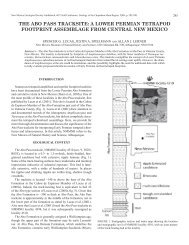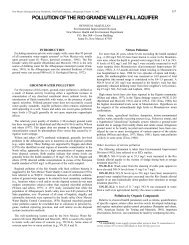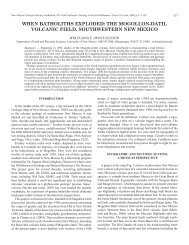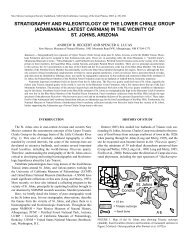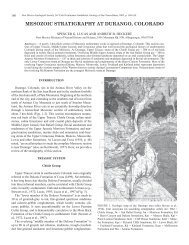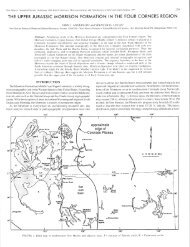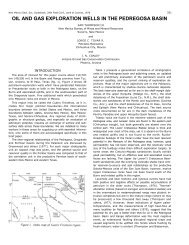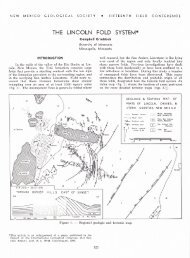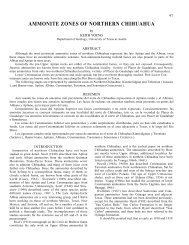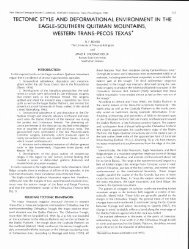Mesozoic stratigraphy of northeastern Chihuahua, Mexico
Mesozoic stratigraphy of northeastern Chihuahua, Mexico
Mesozoic stratigraphy of northeastern Chihuahua, Mexico
Create successful ePaper yourself
Turn your PDF publications into a flip-book with our unique Google optimized e-Paper software.
<strong>Chihuahua</strong> Group<br />
The <strong>Chihuahua</strong> Group (Cordoba, 1969) has been proposed<br />
to include all the formations above the Cuchillo<br />
Formation up to and including the Loma Plata Limestone<br />
above, in <strong>northeastern</strong> <strong>Chihuahua</strong>. Because the Albian<br />
sediments are transgresive and because <strong>of</strong> the numerous<br />
facies changes <strong>of</strong> the units, it is desirable to have a single<br />
group to include these units. The <strong>Chihuahua</strong> Group ranges<br />
in age from early Albian to early Cenomanian.<br />
Benigno Formation.—The name Benigno Formation has<br />
been used by Haenggi (1966) in El Cuervo area for a medium<br />
to dark gray, thick-bedded to massive cliff-forming limestone.<br />
The name has also been used by Cordoba (1968) in<br />
the Juarez mountains for 206 m <strong>of</strong> medium gray, thin- to<br />
thick-bedded limestone, whose upper part is a ridge former.<br />
The Benigno Formation crops out extensively in <strong>northeastern</strong><br />
<strong>Chihuahua</strong>. In the Juarez Mountains (1968) I<br />
measured a section 206 m thick, in El Cuervo area Haenggi<br />
(1966) measured 300 m, in Sierra de la Alcaparra Rodriguez<br />
(1969) measured 372 m, and Caire (1966) measured 323<br />
m in Sierra de San Ignacio. The Benigno Formation is a<br />
cliff-forming limestone in the border range mentioned by<br />
DeFord (1958 ), where Haenggi (1966) used "Benigno<br />
Member" for the upper part <strong>of</strong> the Bluff Mesa.<br />
The unit is located stratigraphically between the Cuchillo<br />
Formation below and the Lágrima Formation above; it is<br />
mainly a thin-bedded to thick-bedded limestone. The upper<br />
part is a ridge former with Toucasia sp.; Orbitolina texana<br />
Romer is found in the middle and lower parts <strong>of</strong> the formation.<br />
Hemiaster sp. and Henallaster sp. are distributed<br />
throughout. Pecten sp. and Trigonia sp. cf. Trigonia emoryi<br />
Conrad are found in Sierra de Juarez; besides the above




